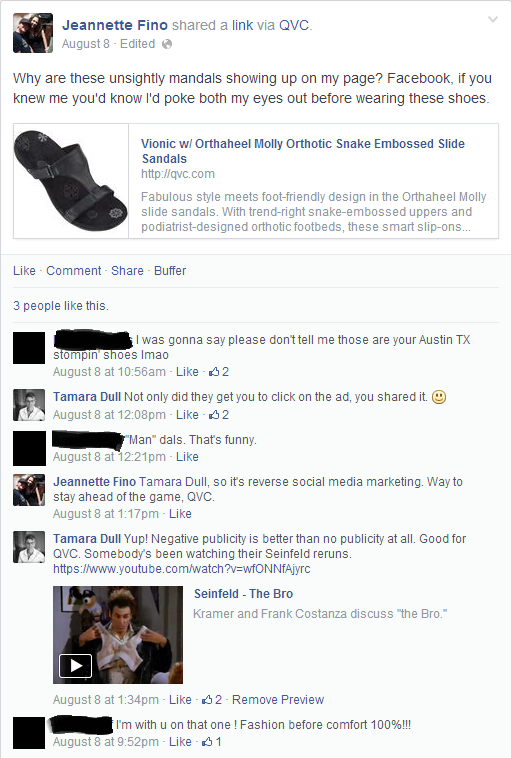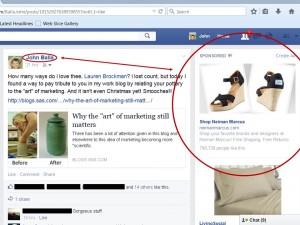
In my last post, Where Do You Draw the Line Between Relevancy and Privacy, I talked about some of the plusses and minuses of behavioral online advertising as it pertains to personal (big data) privacy. Finding the balance between honoring people’s privacy while providing them with an interesting and relevant online experience is tricky, complicated, and an issue of context. What I may consider as a violation of my privacy, you may think nothing of—or what you may consider an invasion of your privacy, I may say, “Wow. That’s cool. And maybe a little creepy.”
And about those targeted online ads. We know marketers are working hard with advertising platforms, such as Google and Facebook, to make sure we’re seeing the “right” ad at the “right” time. Do they always get it right, though? Here’s an entertaining story about a colleague’s run-in with one of Facebook’s ads. You be the judge of who got it right.
The post and ad. Here’s what my colleague, Jeannette, posted on Facebook:

What we know about Jeannette. If Jeannette is your Facebook friend, then you also know this about her from the many posts and images she’s shared over the years:
- Jeannette was born and raised in Los Angeles. She and her family just moved to Austin, Texas, this summer.
- She is an L.A. fashionista who stockpiles highly fashionable footwear.
- When Jeannette moved to Austin, she kept us entertained with a running commentary – complete with photos - on Austin’s (lack of) fashion scene.
- Despite the fashion faux pas, Jeannette LOVES Austin!
What Facebook knows about Jeannette. If you’ve been reading this blog series, you know I haven’t been shy about calling Facebook a machine—a big data machine. It knows and understands Jeannette (and each of us) only through the data we share. The more we share, the more Facebook learns about us. Here’s what we can assume Facebook knows about Jeannette:
- She’s been in Los Angeles since she created her account, but she recently moved to Austin. Facebook knows this through location data, and the fact that she updated her Current City from Los Angeles to Austin.
- She expresses a lot of positive sentiment about fashion, shoes, restaurants and rock & roll.
- She has expressed higher levels of negative sentiment about Austin’s sense of fashion and shoes (but very positive sentiment about their restaurants and music scene).
- She fit into the demographics that the advertiser, QVC, was looking for. That’s why the ad showed up on her profile page.
Is it possible that Facebook really understood Jeannette’s disillusionment with Austin’s fashion scene, and offered up these Austin-appropriate shoes to help her fit in? Perhaps we will never know, but it does make you wonder how effective behavioral online advertising really is.
The IM chat afterwards. After this Facebook exchange, I IMed with Jeannette. The story gets even better. Despite her initial outrage at this ad, Jeannette wrote: “I may now buy something from QVC because of [the ad]. But not those sandals – even though they seem to be popular here.”
Mission accomplished. The advertiser, QVC, gets a +1 because they got a new customer. Jeannette gets a +1 because she discovered a new retail site that can keep her fashionista cravings satisfied. And Facebook gets a +1 because they connected the dots between an advertiser and a buyer.
My only question is: If Jeannette were still in L.A., would she had ever seen this ad for mandals? My vote is no. What do you think?
Author's note: This post was reviewed and approved by Jeannette Fino, who is now the proud owner of four new pairs of shoes from QVC.
Originally written for and published on Smart Data Collective as part of the Big Data MOPS Series.
Editor's note:
 I can totally relate to the cool/creepy reaction here. It seems Jeannette and I are living alternate lives because Facebook is serving me ads for Tom's canvas wedge sandals that Jeannette would probably like (screen-shot to the right).
I can totally relate to the cool/creepy reaction here. It seems Jeannette and I are living alternate lives because Facebook is serving me ads for Tom's canvas wedge sandals that Jeannette would probably like (screen-shot to the right).
The more likely scenario is that the prompt from that ad came from my teenage daughter's not-so-subtle hint about what she'd like Santa to bring her. You see, two weeks ago, she searched for the shoes on my home computer and then left the browser up on the screen - with a handbag in another tab and then a couple of blouses in two other tabs.
So how do I get Facebook to understand that my daughter gave the same not-so-subtle hint to her grandmother, who has already bought the shoes? Our family has moved on from the canvas wedges.
I think that's the next evolution in personalization - where it becomes interactive somehow. I sincerely hope so because I already find these ads annoying and I'm certain I'm not the only one.

2 Comments
FB likely wouldn't have showed it to her had she not been in Austin complaining about fashion. It picked up on her irritation and served her an alternative.
Facebook's data collection can be creepy, but isn't going anywhere. Embrace it and let them show you stuff you may like.
Well I can happily report that I am no longer receiving any ads featuring unsightly footwear from QVC. A result of my several clicks on, "I don't want to see this." My Facebook page is now populated with new fashions closer to my liking. Which brings about a new frustration: having to search the retailer's website for the item advertised instead of providing a direct link. Baby steps.